 |
| APOLLO TEMPLE
Even though it is thought that there was a shrine there before the Ionians came in the 10C BC, a temple at the same site was built in the 6C BC, and later destroyed by the Persians in 494 BC. In the 4C BC Milesians started to rebuild the temple but could not complete it because of financial problems. |
|
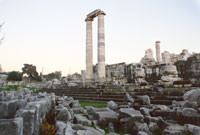 |
|
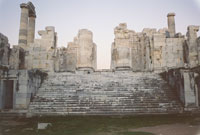 |
|
In the 1C and 4C AD Roman emperors tried but could not complete the construction either. Later in the Byzantine period Theodosius II had a church built in the open air courtyard which was destroyed by an earthquake in the 15C AD. Even in its unfinished state the Apollo Temple was regarded as one of the largest temples of the Hellenistic world, comparable to the Artemis Temple in Ephesus or the Heraion at Samos. |
|
| The temple was 110 m / 360 ft long and 51 m / 167 ft wide with a height of 24 m / 78 ft. It is a dipteros in Ionic order with 120 columns 108 of them surrounding the building by a double row and 12 in the pronaos. As George Bean points out in Aegean Turkey, the Apollo Temple "serves as a reminder that vastness in architecture was not purely a monopoly of the Romans". |
|
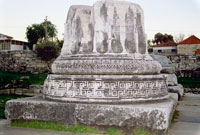 |
|
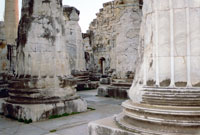 |
|
It was an unusual temple, not only because of its huge size but also for its antechamber with two Corinthian columns and two tunnels that led into the cella. The antechamber which was also termed as Cresmographeion probably served as an oracle office where prophecies were written out and delivered to people. In the middle of the temple there is an open air courtyard (adyton) with another Ionic shrine which housed the cult statue of Apollo. |
|
| There were a few hot springs where the priestess of Didyma immersed her feet or inhaled the water's vapors for inspiration before prophesying. The huge Medusa relief standing next to the temple is a 2C AD piece which has fallen off the frieze. A little further stand the remains of an altar and a well. Before asking for a prophesy from the priests in the pronaos, people purified themselves with water from the well and gave votive offerings in the altar. |
|
 |
|
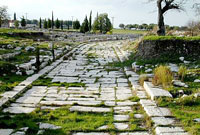 |
|
THE SACRED WAY
The road starting from the Miletus' Holy Gate follows the shoreline to the south and reaches to the harbor of Didyma, called Panormos. Then it continues to the south again with statues, recumbent lions, statues of the priests of the temple of Apollon and the sphinxes on both sides of the road for the last 6km. to the temple of |
|
| Apollon. The distance between Miletus and the temple of Apollon is about 16 km. The entire road is stone paved. Although the sacred road is well preserved generally, there are certain segments which could not be identified fully yet. During the excavations in 1975 Temple of Artemis was revealed. The other way of reaching to Didyma is over the sea-route via Port Panormas. A 6km. sacred land road was the last part of this journey. |
|
 |
|
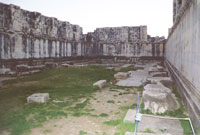 |
|
THE CULT
The scientific knowledge about the cult in Didyma is not much. All we know is the information obtained from a marble stele, which was written in the 2nd century B.C. found in Delphi of Miletus. According to the writings, they used to make one major ceremonial worship once a year in spring. |
|
| As the rites in Apollo Delphi was over, they were leaving Miletus through the Holy Gate and setting up to the Sacred Road, to Didyma. This ceremonial walk used to take 4 days before they reach to the temple of Apollon in Didyma. They would offer sacrifices to Apollon in front of the sacred quarters. After a final holy ceremony in the Apollon temple the annual worship would end. |
|
 |
|
| The whole ceremony was conducted under the leadership of a family of priests. During the time of Theodasius (395 A.C.), oracling was forbidden in the temple of Apollon. |
|
|
 |
|
|
|